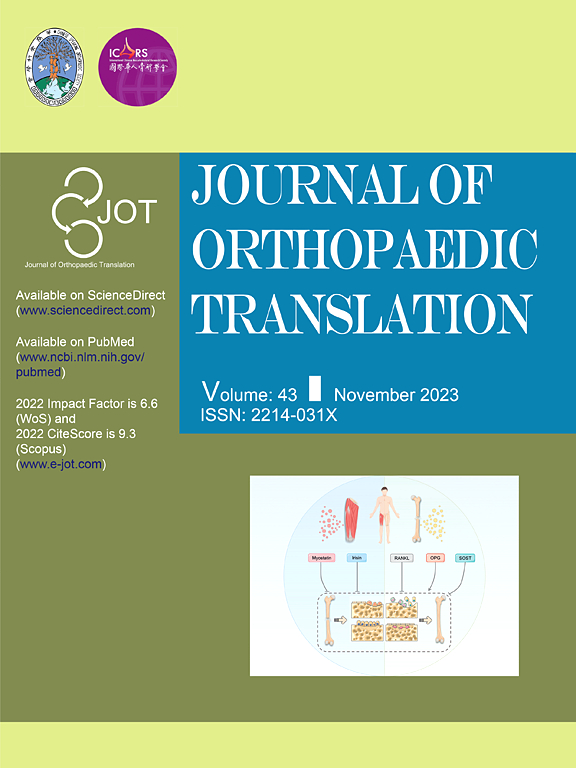Mitochondrial destabilization in tendinopathy and potential therapeutic strategies
IF 5.9
1区 医学
Q1 ORTHOPEDICS
引用次数: 0
Abstract
Tendinopathy is a prevalent aging-related disorder characterized by pain, swelling, and impaired function, often resulting from micro-scarring and degeneration caused by overuse or trauma. Current interventions for tendinopathy have limited efficacy, highlighting the need for innovative therapies. Mitochondria play an underappreciated and yet crucial role in tenocytes function, including energy production, redox homeostasis, autophagy, and calcium regulation. Abnormalities in mitochondrial function may lead to cellular senescence. Within this context, this review provides an overview of the physiological functions of mitochondria in tendons and presents current insights into mitochondrial dysfunction in tendinopathy. It also proposes potential therapeutic strategies that focus on targeting mitochondrial health in tenocytes. These strategies include: (1) utilizing reactive oxygen species (ROS) scavengers to mitigate the detrimental effects of aberrant mitochondria, (2) employing mitochondria-protecting agents to reduce the production of dysfunctional mitochondria, and (3) supplementing with exogenous normal mitochondria. In conclusion, mitochondria-targeted therapies hold great promise for restoring mitochondrial function and improving outcomes in patients with tendinopathy.
The translational potential of this article: Tendinopathy is challenging to treat effectively due to its poorly understood pathogenesis. This review thoroughly analyzes the role of mitochondria in tenocytes and proposes potential strategies for the mitochondrial treatment of tendinopathy. These findings establish a theoretical basis for future research and the clinical translation of mitochondrial therapy for tendinopathy.

肌腱病中的线粒体失稳与潜在治疗策略
肌腱病是一种普遍存在的与衰老有关的疾病,其特点是疼痛、肿胀和功能受损,通常是由于过度使用或创伤引起的微瘢痕和变性造成的。目前对肌腱病的干预措施疗效有限,这凸显了对创新疗法的需求。线粒体在腱细胞功能中发挥着不被重视但却至关重要的作用,包括能量产生、氧化还原平衡、自噬和钙调节。线粒体功能异常可能导致细胞衰老。在此背景下,本综述概述了线粒体在肌腱中的生理功能,并介绍了目前对肌腱病中线粒体功能障碍的见解。它还提出了针对腱细胞线粒体健康的潜在治疗策略。这些策略包括(1)利用活性氧(ROS)清除剂减轻异常线粒体的有害影响;(2)使用线粒体保护剂减少功能障碍线粒体的产生;以及(3)补充外源性正常线粒体。总之,线粒体靶向疗法在恢复线粒体功能和改善腱鞘病患者预后方面大有可为:由于对腱鞘炎的发病机制知之甚少,有效治疗腱鞘炎具有挑战性。这篇综述深入分析了线粒体在腱鞘细胞中的作用,并提出了线粒体治疗腱鞘炎的潜在策略。这些发现为线粒体疗法治疗腱鞘炎的未来研究和临床转化奠定了理论基础。
本文章由计算机程序翻译,如有差异,请以英文原文为准。
求助全文
约1分钟内获得全文
求助全文
来源期刊

Journal of Orthopaedic Translation
Medicine-Orthopedics and Sports Medicine
CiteScore
11.80
自引率
13.60%
发文量
91
审稿时长
29 days
期刊介绍:
The Journal of Orthopaedic Translation (JOT) is the official peer-reviewed, open access journal of the Chinese Speaking Orthopaedic Society (CSOS) and the International Chinese Musculoskeletal Research Society (ICMRS). It is published quarterly, in January, April, July and October, by Elsevier.
 求助内容:
求助内容: 应助结果提醒方式:
应助结果提醒方式:


